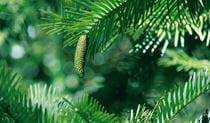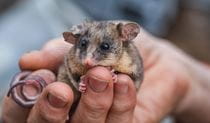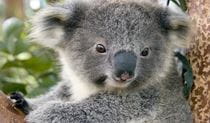Eastern bristlebird
The endangered eastern bristlebird is a shy, ground-dwelling songbird. Less than 2,500 birds are left in the wild, restricted to 3 isolated areas in eastern NSW and southern Queensland.
Eastern bristlebirds are medium-sized songbirds, with cinnamon-brown feathers, a pale throat, and striking red eyes. They get their name from stiff, bristle-like ‘whiskers’ that sprout from the base of their beak. No one really knows the bristles’ purpose, though they might help the birds sense their grassy environment.
Bristlebirds are agile ground scamps, preferring to scurry through dense undergrowth rather than fly, as they search for insects, seeds and small fruits.
They can be tricky to see, but their loud, melodious voice will brighten up any birdwatcher’s day.

Listen to an eastern bristlebird's call
Audio © David Stewart Naturesound
Few and far between
Eastern bristlebirds were once far more widely spread across their range. Today in NSW, less than 2,500 individual birds remain in the wild across 3 geographically isolated coastal populations.
The species’ stronghold is on the Shoalhaven Coast and the escarpments behind Kiama. A smaller population straddles the NSW/Victoria border in Nadgee National Park. The most contracted population, with around 40 birds, is found on the NSW border with Queensland, around Border Ranges National Park.
Bristlebirds move mainly by running or flying low to the ground, preferring to forage in grassland environments. While their southern kin live in coastal heath and shrubland, the northern bristlebirds rely on a unique habitat of open tussocky grass sites, next to rainforest or wet gullies, for their feeding and breeding.
3 facts about eastern bristlebirds
Animal facts
- Common name
- Eastern bristlebird
- Scientific name
- Dasyornis brachypterus
- Conservation status in NSW
- Endangered
Threats and conservation
As land management practices have changed, Eastern Bristlebird distribution has shrunk. The remaining populations have less resilience to threats like wildfire, habitat loss, disease and climate change impacts. With so few birds, these small, disconnected populations are at risk of extinction.
Feral predators like foxes and cats also pose a significant risk to ground-dwelling birds, along with habitat loss.
For the small northern population, a habitat restoration program is expanding the area of grassy open forest habitat they need for breeding. A captive breeding and release program is also helping to bolster these rare birds’ chances of survival.
Extra special protections
Several areas within NSW national parks have been declared Assets of Intergenerational Significance (AIS) to provide the strongest protections for eastern bristlebirds and their habitat. These include:
You might also like
-

Eastern bristlebird conservation program
The eastern bristlebird recovery program is helping to reverse the decline in populations of these rare and endangered native Australian birds.
-

Assets of Intergenerational Significance (AIS)
Assets of Intergenerational Significance (AIS) are declared to bolster protections for an area with exceptional environmental or cultural values, like...
-

Protecting threatened species in parks
Around 84% of the approximately 900 threatened species in NSW are found in our national parks and reserves. Find out what we're doing to protect threa...
-

Saving our Species conservation program
Today, we're at risk of losing nearly 1000 of our state's native animals and plants. That's why the NSW Government established Saving our Species. It'...





